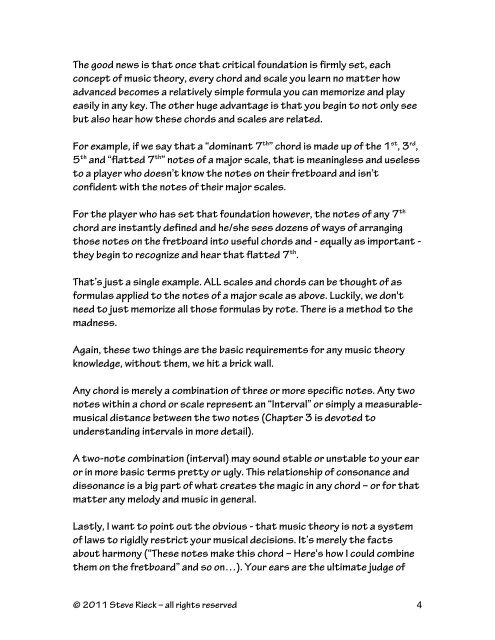Fretboard Evolution Vol. I - Steve Rieck
Fretboard Evolution Vol. I - Steve Rieck
Fretboard Evolution Vol. I - Steve Rieck
You also want an ePaper? Increase the reach of your titles
YUMPU automatically turns print PDFs into web optimized ePapers that Google loves.
The good news is that once that critical foundation is firmly set, each<br />
concept of music theory, every chord and scale you learn no matter how<br />
advanced becomes a relatively simple formula you can memorize and play<br />
easily in any key. The other huge advantage is that you begin to not only see<br />
but also hear how these chords and scales are related.<br />
For example, if we say that a “dominant 7 th ” chord is made up of the 1 st , 3 rd ,<br />
5 th and “flatted 7 th ” notes of a major scale, that is meaningless and useless<br />
to a player who doesn’t know the notes on their fretboard and isn’t<br />
confident with the notes of their major scales.<br />
For the player who has set that foundation however, the notes of any 7 th<br />
chord are instantly defined and he/she sees dozens of ways of arranging<br />
those notes on the fretboard into useful chords and - equally as important -<br />
they begin to recognize and hear that flatted 7 th .<br />
That’s just a single example. ALL scales and chords can be thought of as<br />
formulas applied to the notes of a major scale as above. Luckily, we don't<br />
need to just memorize all those formulas by rote. There is a method to the<br />
madness.<br />
Again, these two things are the basic requirements for any music theory<br />
knowledge, without them, we hit a brick wall.<br />
Any chord is merely a combination of three or more specific notes. Any two<br />
notes within a chord or scale represent an “Interval” or simply a measurablemusical<br />
distance between the two notes (Chapter 3 is devoted to<br />
understanding intervals in more detail).<br />
A two-note combination (interval) may sound stable or unstable to your ear<br />
or in more basic terms pretty or ugly. This relationship of consonance and<br />
dissonance is a big part of what creates the magic in any chord – or for that<br />
matter any melody and music in general.<br />
Lastly, I want to point out the obvious - that music theory is not a system<br />
of laws to rigidly restrict your musical decisions. It’s merely the facts<br />
about harmony (“These notes make this chord – Here's how I could combine<br />
them on the fretboard” and so on…). Your ears are the ultimate judge of<br />
© 2011 <strong>Steve</strong> <strong>Rieck</strong> – all rights reserved 4


